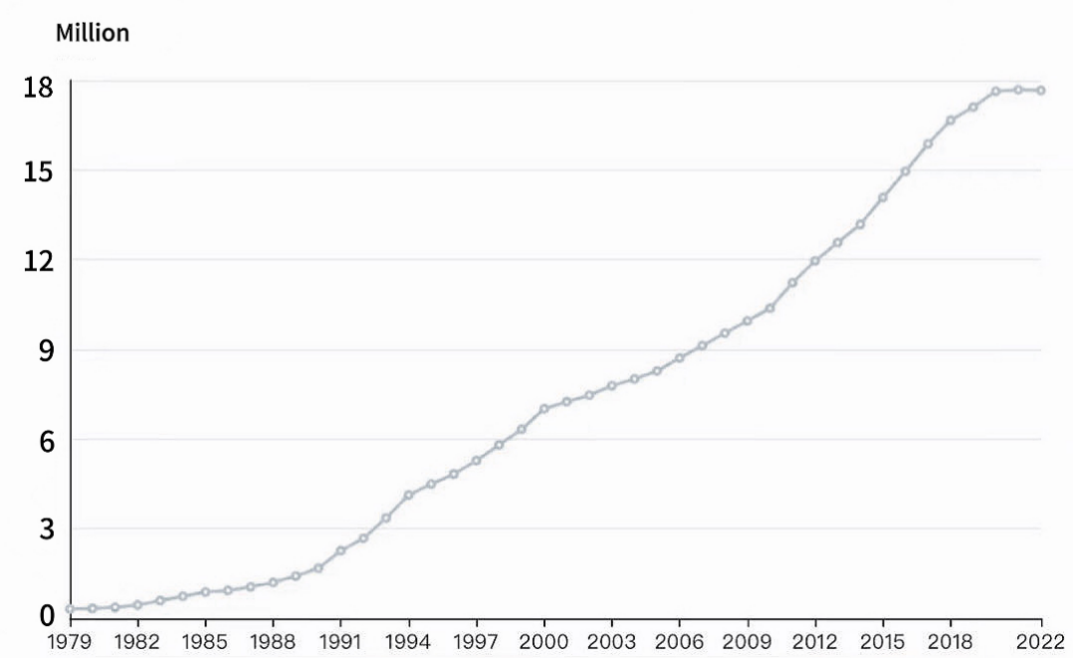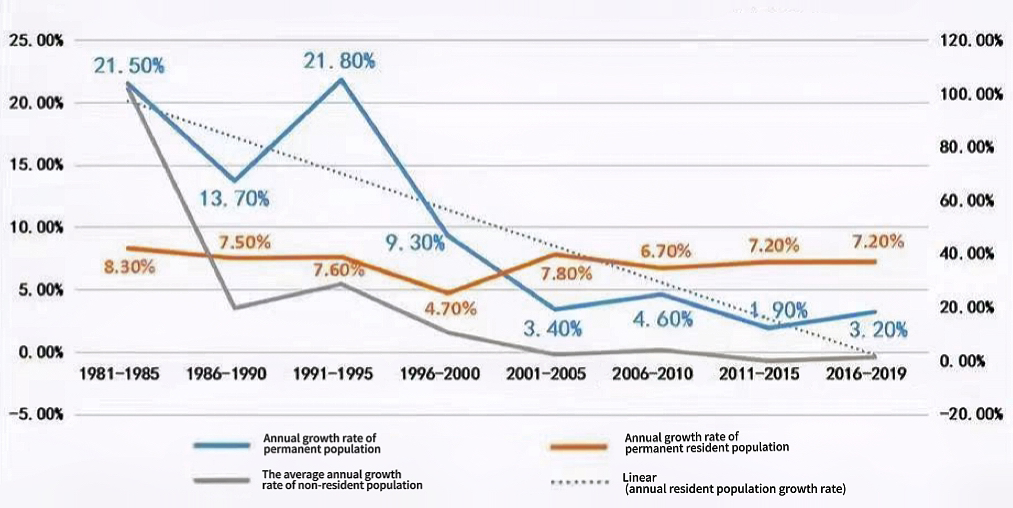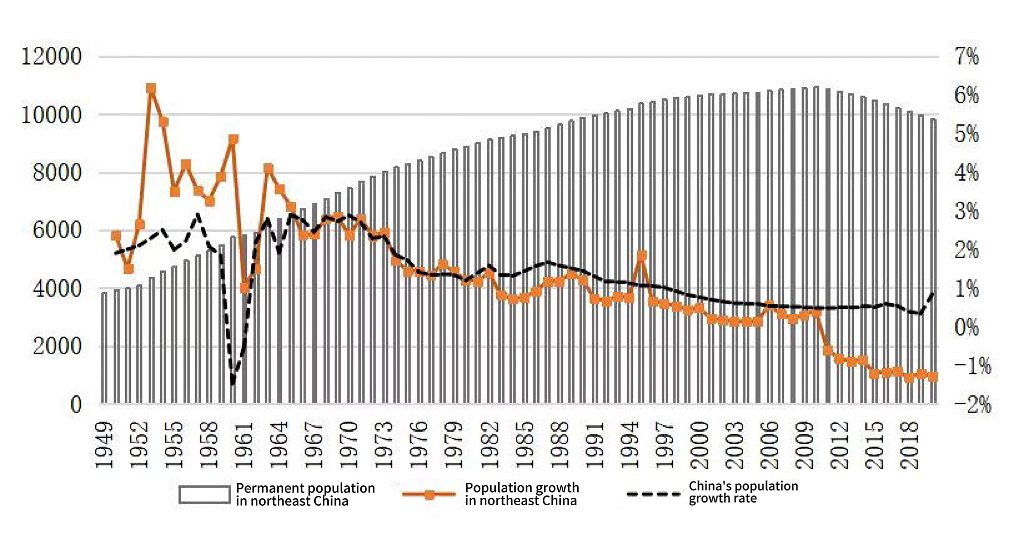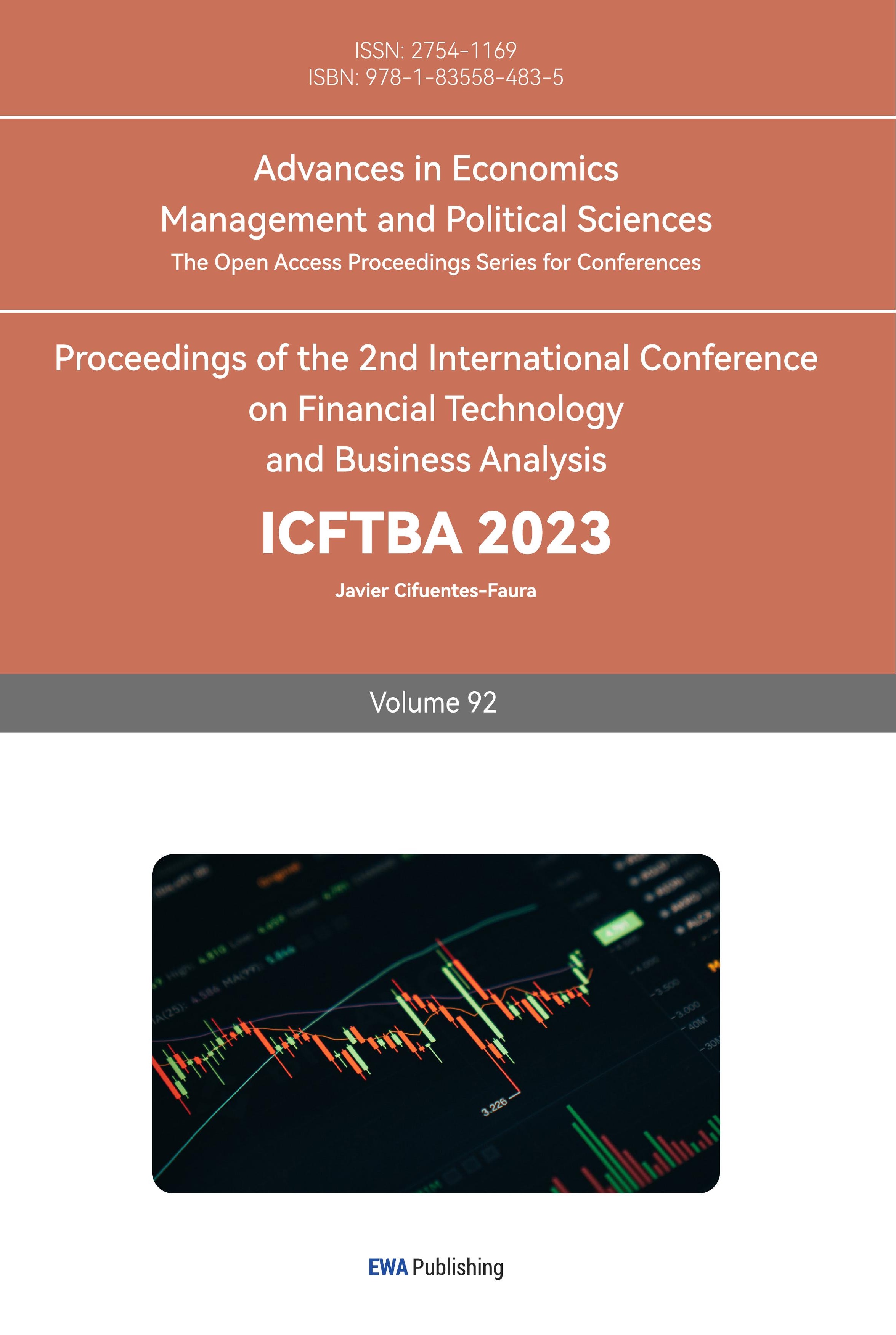1. Introduction
It is essential to discover the relationship between China's financial system and urbanization for numerous reasons.
Firstly, urbanization is a critical driving force of China's financial boom. The boom in the population of urban dwellers generates demand for a range of items and services, growing intake at the same time as at the identical time stimulating the method of industrialization.
Secondly, urbanization influences the allocation of resources which includes land, labor, and capital. Analyzing the allocation of sources inside the urbanization procedure can provide us with better expertise on China's economic efficiency and regional improvement gaps.
Furthermore, Chinese government regulations play a crucial role in urbanization and monetary development. Thus, analyzing the relationship between urbanization and economic improvement will help national policymakers make knowledgeable choices with the purpose of sure sustainable city development and monetary balance. [1]
My essay targets, first, to take a look at the historical trends and patterns of urbanization in China and its relevance to monetary situations.
Second, my goal is to investigate the impact of urbanization on key monetary sectors inclusive of manufacturing, offerings, and infrastructure improvement.
Third, this essay ambitions to examine the position of government coverage in urbanization and economic boom and examine whether it's miles powerful.
Also, my essay explores the challenges and trade-offs associated with rapid urbanization, such as environmental degradation, social inequality, and pressure on infrastructure. Examining these issues in depth, contributes to a better understanding of the interactions between China's economy and urbanization, and provides valuable information for policymakers, economists, and urban planners to guide China toward sustainable development.
The research question is:
What is the relationship between China's economic performance and its urbanization patterns?
2. Literature Review
Current research highlights the complex interplay between the Chinese economy and urbanization. The explosive population movement during the 13th Five-Year Plan was fueled by economic growth, industrialization, and urbanization policies. An exemplary case is Shenzhen, which transformed into a global tech hub, attracting a massive influx of migrants seeking employment opportunities. The influence of "first nature" and "second nature" on urbanization is evident. Eastern China benefits from coastal access and established infrastructure, while Western China faces challenges due to limited resources and underdeveloped infrastructure.
The results of the seventh census demonstrate that China's urbanization rate has exceeded 60%. This indicates a significant shift but also exposes disparities between urban and rural regions, necessitating further exploration.1
Critical studies have examined the factors contributing to China's urbanization but often lack depth in localized dynamics. While recognizing the impact of first and second nature, these studies might not adequately address how resource disparities and environmental conditions influence population mobility between the eastern and western parts of China. Furthermore, existing studies might focus on major urban centers like Shenzhen but often overlook the unique challenges and opportunities faced by regions like northeast China. These challenges can encompass political factors, human capital, and geographical constraints.
The research gap I’m addressing involves a comprehensive exploration of urbanization dynamics at both micro and regional levels. While specializing in Shenzhen's case, my research extends to inspecting the urbanization dynamics of China's northeast areas. I plan to conduct a complete evaluation of ways political, human, and geographical elements have influenced urbanization in these areas.
Northeast China's decline in conventional industries, coupled with political considerations and geographical remoteness, presents a unique context for urbanization. I goal to uncover how those elements interplay with monetary strategies and concrete development policies. In order to fill this hole, my study objectives are to provide a holistic knowledge of the full photo of urbanization in China, while additionally taking into consideration the various demanding situations going through one-of-a-kind areas and offering focused insights for coverage interventions. Expected results are listed below.
In my deep exploration of the relationship between urbanization and economic development, as witnessed through the cases of Shenzhen and the northeastern provinces in China, I've journeyed through a dynamic interplay that holds profound implications for the growth and prosperity of regions and nations.
One of the central revelations from my comparative analysis is the unmistakable pattern of cities and economies growing together. It's akin to a dance where each partner complements the other, and Shenzhen and the northeastern provinces have gracefully demonstrated this synergy. While the pace and style of this growth may differ, the overarching trend is consistent: when cities expand, economies tend to flourish.
A pivotal driving force behind this phenomenon is the transformative nature of urbanization. As cities burgeon, they become hotbeds of economic evolution. Shenzhen's remarkable trajectory, marked by its pivot towards high-tech industries and the flourishing services sector, underscores how urbanization can fuel economic diversification and prosperity. Conversely, the northeastern provinces' ambitious efforts to move away from heavy industries find a kindred spirit in the strategic urbanization initiatives that align with these aspirations.
Government policies emerge as the conductors orchestrating this symphony of urbanization and economic growth. Shenzhen's ascent was facilitated by policies that fostered innovation and entrepreneurship, creating an environment ripe for business innovation. In contrast, the northeastern provinces' journey towards economic restructuring was intimately intertwined with policies aimed at reducing reliance on declining industries. This underscores the profound impact of policy alignment with the dynamics of urbanization on economic outcomes.
Infrastructure development, a common thread woven into the narratives of both Shenzhen and the northeastern provinces, takes on the role of an enabler in this story. Investments in transportation networks, technology hubs, and other essential infrastructure elements not only stimulate immediate economic growth through job creation and construction but also lay the foundations for enduring economic prosperity. The improved connectivity and efficiency brought about by these investments are instrumental in sustaining economic growth.
One of the most captivating aspects of urbanization is its influence on the composition of the labor force and the emergence of expansive consumer markets. As people migrate from rural to urban areas, cities become magnets for talent, fostering innovation and boosting productivity. Additionally, the swelling urban populations create substantial consumer markets that attract businesses and drive economic growth through increased demand.
However, it's vital to acknowledge that the journey of urbanization is not without its hurdles. The rapid growth of cities can give rise to challenges like traffic congestion and environmental concerns. If these issues are not effectively managed, they have the potential to hinder economic progress.
In summary, my research has unveiled a robust and intricate relationship between urbanization and economic development. This connection underscores the importance of synchronized urban planning and economic strategies. Yet, it's essential to recognize that this intricate dance is not performed in isolation.
Economic systems, such as how a country's economy is structured, exert significant influence on the pace and nature of urbanization. In China's case, its market-oriented economic system has been a driving force behind the rapid urbanization I've witnessed in both Shenzhen and the northeastern provinces. Economic systems act as amplifiers of the forces propelling urbanization, facilitating industrialization and labor migration from rural to urban areas.
Moreover, the level of economic development provides the solid ground upon which urbanization can thrive. Higher levels of economic development provide the resources necessary for infrastructure development, education, and healthcare. Simultaneously, urbanization, in a reciprocal manner, contributes to economic development by enhancing productivity and stimulating consumption. This mutual reinforcement creates a virtuous cycle of growth.
In conclusion, my comparative analysis of Shenzhen and the northeastern provinces in China serves as a compelling testament to the multifaceted yet pivotal relationship between urbanization and economic development. While common threads run through positive correlation, economic restructuring, government policies, infrastructure investment, and the allure of an expanding labor force and consumer market, the interplay of economic systems and developmental stages shapes the trajectory of urbanization. Concomitantly, urbanization wields its influence on the economy, fostering productivity, expanding consumer markets, and spurring infrastructure development.
This understanding of the intricate dance between urbanization and economic growth is of paramount importance for policymakers and stakeholders as they navigate the multifaceted terrains of urbanization and economic development. It invites further exploration and research to uncover nuanced policy implications that ensure the sustainable progression of development in an evolving global landscape. As I conclude this chapter, it is not an endpoint but a stepping stone to further discovery and understanding in this intricate and ever-evolving relationship.
3. The Relation with Large Issues
In the improvement manner of a region, urbanization, and monetary growth are often closely associated. Urbanization is the inevitable result of social and economic improvement, and a chain of modifications brought by way of it's far a crucial supply of financial increase.
4. Methods
Quantitative Analysis: Conduct regression analysis to assess the relationship between economic growth and urbanization rates.
Comparative Analysis: Compare urbanization patterns in China with other countries to identify unique factors driving China's urbanization.
Historical Analysis: Utilize archival data and historical records to understand the long-term relationship between the economy and urban development.
4.1. How to collect data
My approach involves employing statistical analysis to delve into the relationship between economic indicators and the pace of urbanization within particular Chinese cities. I will gather and scrutinize pertinent economic indicators like GDP and industrial output. Additionally, I will source urbanization data from official channels such as China's National Bureau of Statistics, including figures on urban population and the urbanization rate. This comprehensive data-driven examination aims to provide a thorough understanding of the urbanization landscape in China.
5. Detailed Examples
5.1. Shenzhen
5.1.1. Special economic zones and industrialization (1980s)
Specific case: Shenzhen was designated as a special economic zone in 1980, marking a critical moment in its economic history.
Policy: The central government has introduced the policy of special economic zones to attract foreign investment and promote economic growth.
Data: The population of Shenzhen surged from about 30,000 in 1980 to more than 12 million in 2019.
Explanation: The policy of special economic zones has led to rapid industrialization, attracting a large influx of immigrants to seek employment opportunities in newly established factories. The influx of population has greatly promoted the urbanization of Shenzhen.
5.1.2. Reform and opening up (1980s to 1990s)

Figure 1: Shenzhen: Number of resident population
Specific cases: The introduction of market-oriented reforms in the 1980s and 1990s promoted Shenzhen's economic growth.
Policy: China has accepted economic liberalization and joined international trade.
Data: Since the 1980s, Shenzhen's GDP has soared from 196 million Yuan in 1980 to more than 2.7 trillion Yuan in 2019.
Explanation: The policy change has attracted foreign investment and promoted the establishment of different industries. This economic expansion has generated the demand for labor, attracted immigrants from various regions, and promoted urbanization. [2]
5.1.3. Technology and Innovation (2000s)
Specific case: The creation of Shenzhen High-tech Industrial Park reflects the transformation of Shenzhen to technology and innovation.
Policy: The government focuses on promoting a technology-driven economy.
Data: According to the statistics of the Ministry of Science and Technology of China, the science and technology industry accounted for more than 34% of Shenzhen's GDP in 2019.
Explanation: The development of the technology industry has attracted professionals, researchers, and entrepreneurs with advanced skills. This kind of talent migration has led to the growth of urban areas around the science and technology center.

Figure 2: Average annual population growth in Shenzhen from 1981 to 2019
5.1.4. Entrepreneurship and start-ups (2010s to the present)
Specific case: The establishment of Shenzhen Entrepreneurship Village highlights the policy of supporting entrepreneurship.
Policy: China aims to encourage innovation and start-ups.
Data: Shenzhen has more than 17,000 start-ups as of 2020.
Explanation: Favorable policies have attracted a wave of young entrepreneurs and professionals. The influx of start-ups and innovative enterprises has contributed to urbanization by shaping vibrant urban communities.
5.1.5. Financial and service sectors (2010s to the present)
Specific case: The development of Qianhai Shenzhen-Hong Kong Modern Service Industry Cooperation Zone illustrates Shenzhen's expansion into the financial and service sector.
Policy: China aims to promote cooperation between finance and services and Hong Kong.
Data: By 2020, Qianhai had attracted more than 120,000 registered companies.
Explanation: The growth of the financial and service sectors has attracted a variety of professionals and enterprises, further promoting urbanization.
5.2. Liaoning province
5.2.1. 1950s and 1960s: Economic boom and urban influx
During this period, policies emphasizing heavy industrialization spurred significant economic growth in Liaoning. Shenyang became an industrial city, and a strong industrial sector created a huge demand for labor, leading to a surge in urbanization.
A Shenyang Case is that the establishment of Shenyang as a key industrial center attracted people seeking employment opportunities. Shenyang's population has soared from about 1 million in the 1950s to more than 8 million in 2019. The dependence of the economies of the three eastern provinces on heavy industry has played a role in attracting urban migrants.
5.2.2. 1970s and 1980s: Economic stagnation and urban adjustment
At this stage, economic challenges emerged that affected the rate of urbanization. Policy changes and a relative slowdown in economic growth have affected the pace of urbanization.
5.2.3. 1990s - 2000s: Economic reform and population transfer
Economic reform and globalization have changed the landscape. Migration is caused by employment opportunities in more developed areas and affects urbanization dynamics.
Population mobility in the population of the Northeast fell from about 108 million in 2010 to about 106 million in 2019. The decline highlights how economic changes have led individuals to seek better opportunities elsewhere, affecting urbanization rates.
5.2.4. 2000s to present: Revitalization efforts and urban renewal
Revitalization policies focusing on technological progress and innovation have reignited economic growth. This, in turn, affects urbanization patterns.
Shenyang Hi-Tech Industrial Development Zone: The creation of technological development zones, such as the Shenyang Hi-Tech Industrial Development Zone, has attracted investment and contributed to economic growth and urbanization. Urbanization has responded to the opportunities presented by these emerging sectors. In essence, urbanization in the Northeast is deeply intertwined with its economic evolution. [3]
6. Conclusions and Implications
6.1. Main conclusions
Adverse macro-environmental factors have not restrained China's population mobility and urbanization in the past decade.

Figure 3: Population growth in Northeast China from 1848 to 2018
The intensive implementation of national strategies, especially during the 13th Five-Year Plan period, has greatly stimulated and promoted rapid population mobility and urbanization in China.
Population separation and mobility have grown rapidly, driven by the government's administrative dominance and institutional advantages.
The scale and intensity of population flow have been increasing rapidly since 2000, but the speed of population flow has shown a decreasing trend due to the influence of domestic and foreign macro-environmental factors, aligning with the slowing trend of economic growth.
Population migration is mainly influenced by "the first nature" and "the second nature" factors, as well as regional economic development differences. Less developed areas in central and western regions primarily migrate to developed areas in the east, and rural populations tend to migrate to cities, leading to enhanced rural-urban population migration. [4]
Rural-urban population flow remains the mainstream of China's population flow, with the scale of the rural-urban floating population growing faster than the urban floating population. The role of rural-urban population flow in promoting urbanization is increasing, especially the influx of population into urban areas.
The implementation of national strategies mainly results in the separation of people and households in active urban districts and close-distance population flow. International macro-environmental factors, such as Sino-US trade friction, affect economic growth and employment opportunities in big cities, restricting population flow in distant cities.[5] Since 2010, population separation in China has been dominated by rapid growth in urban districts and near-distance population flow, leading to "local" urbanization within administrative divisions and "nearby" urbanization through close-distance population flow.
6.2. Analysis
Economic Resilience in the Face of Adverse Factors: The article highlights that domestic and foreign macro-environmental factors, such as the international financial crisis, trade frictions, and the COVID-19 pandemic, have posed challenges to China's population mobility and urbanization. Despite these adverse factors, China's economy has displayed resilience and has not been significantly restrained or weakened in terms of population mobility and urbanization development. This suggests that economic factors play a crucial role in driving urbanization trends, even amid external challenges.
The execution of national policies, particularly during the 13th Five-Year Plan era, has contributed to the encouragement of population movement and urban growth in China. Initiatives like the New Urbanization Strategy, Poverty Alleviation Strategy, and Rural Revitalization Strategy have effectively countered the adverse effects of broader environmental factors. By addressing regional development disparities and emphasizing inclusive progress, these initiatives have spurred swift urbanization. This success underscores the significance of tailored economic measures in driving urban development. Administrative leadership and government agency direction have also played pivotal roles in facilitating rapid population movement and urbanization.
Administrative centralization has allowed for efficient implementation of urbanization plans and policies, promoting urban-rural integration. Furthermore, the growth in population flow and urbanization has shown a correlation with economic growth. As the economy expands, population flow also increases, underscoring the interconnectedness between economic development and urbanization trends.
Regional Disparities and Migration Patterns: Economic disparities between less-developed central and western regions and more developed eastern regions have influenced population migration patterns. The article indicates that migration is predominantly from less developed areas to more developed ones, with rural populations migrating to urban areas. Economic incentives and opportunities in developed regions attract migrants seeking better living standards and employment prospects. This demonstrates how economic development acts as a pull factor in shaping population flow and urbanization dynamics.
Increasing Role of Rural-Urban Population Flow: Despite the growth in urban population, rural-urban population flow remains the mainstream trend in China's urbanization. This migration from rural to urban areas indicates the significant role of economic factors in driving urbanization. Economic opportunities and better living conditions in cities draw rural populations seeking upward mobility. The increasing scale and proportion of rural-urban population flow underscore the ongoing importance of economic growth in the urbanization process.
In conclusion, economic factors play a pivotal role in shaping population mobility and urbanization trends in China. The economy's resilience to adverse factors, the success of national strategies in promoting urbanization, the correlation between population flow and economic growth, and regional economic disparities driving migration patterns all illustrate the significant impact of the economy on urbanization. As China continues to develop, policymakers must consider economic development and inclusive strategies to ensure sustainable and balanced urbanization across the country.
6.3. Several issues worth exploring further in the paper
Data adjustment: The paper discusses three main problems related to data adjustment. These include whether relevant population survey statistics data can be adjusted based on the "seven popular" data since 2011, whether the way of data adjustment is reasonable, and contradictions between the adjusted data and reality.
The sustainability of "explosive" growth in population flow and rapid urbanization: The paper raises the question of whether the current rate of population flow and urbanization growth can be sustained, considering the influence of macroeconomic environmental factors, the continuity of national strategies, and the development laws of population mobility and urbanization.
The paper dives into the nuances of populace mobility and urbanization fine. It points out numerous key troubles, together with the rapid increase in populace dispersion inside urban areas, the superiority of brief-distance population actions main to close-by urbanization, and the continued coexistence of different urbanization tracks. When it involves the paper's strong factors, it offers a thorough evaluation of population mobility and urbanization in China. It explores how elements just like the surroundings, national strategies, and regional monetary disparities have an impact on population actions. The paper also emphasizes the importance of prioritizing the fine of population migration and urbanization as opposed to definitely specializing in the rate of increase.
6.4. improvements
In terms of regions for development, the paper may want to advantage of presenting extra precise proof and citing facts and sources for its analysis and conclusions. It ought to additionally deal with ability barriers in its data adjustment methods, acknowledging uncertainties in those adjustments. Further examination of the social and financial outcomes of fast population dispersion and brief-distance motion is warranted.
Additionally, the paper must explore capability measures to address the challenges posed through the two-tiered urbanization system and enhance urbanization high-quality. Lastly, considering the lengthy-term sustainability and implications of national strategies on population mobility and urbanization past the thirteenth Five-Year Plan period is important.
Precisely, this paper offers treasured insights into the tendencies of populace mobility and urbanization in China. However, addressing the regions of improvement stated above could decorate the paper's credibility and contribute to a more comprehensive understanding of the situation matter.
References
[1]. Gao Fan." Logical transitions in China's urbanisation: implications and significance." Social Science .08(2022):109-119. Doi: 10.13644/j.cnki.cn31-1112.2022.08.018.
[2]. Zou Bing." From the Special Administrative Region to the Greater Bay Area Shenzhen's Historical Contribution and Future Responsibility to China's Urbanisation." Times Architecture .04(2019):12-17. Doi: 10.13717/j.cnki.ta.2019.04.004.
[3]. Yao Kang,and Zhou Liya." From Rapid Urbanisation to Deep Urbanisation - Exploration of Shenzhen's New Urbanisation Path." Residential and Real Estate .24(2017):15-16.
[4]. Di Clemente, R., Strano, E. & Batty, M. Urbanization and economic complexity. Sci Rep 11, 3952 (2021). https://doi.org/10.1038/s41598-021-83238-5
[5]. Duranton, G. Growing through cities in developing countries. The World Bank Research Observer 30, 39–73. https://doi.org/10.1093/wbro/lku006 (2014).
Cite this article
Liu,S. (2024). The Nexus of China's Economy and Urbanization: A Quantitative and Historical Analysis. Advances in Economics, Management and Political Sciences,92,21-30.
Data availability
The datasets used and/or analyzed during the current study will be available from the authors upon reasonable request.
Disclaimer/Publisher's Note
The statements, opinions and data contained in all publications are solely those of the individual author(s) and contributor(s) and not of EWA Publishing and/or the editor(s). EWA Publishing and/or the editor(s) disclaim responsibility for any injury to people or property resulting from any ideas, methods, instructions or products referred to in the content.
About volume
Volume title: Proceedings of the 2nd International Conference on Financial Technology and Business Analysis
© 2024 by the author(s). Licensee EWA Publishing, Oxford, UK. This article is an open access article distributed under the terms and
conditions of the Creative Commons Attribution (CC BY) license. Authors who
publish this series agree to the following terms:
1. Authors retain copyright and grant the series right of first publication with the work simultaneously licensed under a Creative Commons
Attribution License that allows others to share the work with an acknowledgment of the work's authorship and initial publication in this
series.
2. Authors are able to enter into separate, additional contractual arrangements for the non-exclusive distribution of the series's published
version of the work (e.g., post it to an institutional repository or publish it in a book), with an acknowledgment of its initial
publication in this series.
3. Authors are permitted and encouraged to post their work online (e.g., in institutional repositories or on their website) prior to and
during the submission process, as it can lead to productive exchanges, as well as earlier and greater citation of published work (See
Open access policy for details).
References
[1]. Gao Fan." Logical transitions in China's urbanisation: implications and significance." Social Science .08(2022):109-119. Doi: 10.13644/j.cnki.cn31-1112.2022.08.018.
[2]. Zou Bing." From the Special Administrative Region to the Greater Bay Area Shenzhen's Historical Contribution and Future Responsibility to China's Urbanisation." Times Architecture .04(2019):12-17. Doi: 10.13717/j.cnki.ta.2019.04.004.
[3]. Yao Kang,and Zhou Liya." From Rapid Urbanisation to Deep Urbanisation - Exploration of Shenzhen's New Urbanisation Path." Residential and Real Estate .24(2017):15-16.
[4]. Di Clemente, R., Strano, E. & Batty, M. Urbanization and economic complexity. Sci Rep 11, 3952 (2021). https://doi.org/10.1038/s41598-021-83238-5
[5]. Duranton, G. Growing through cities in developing countries. The World Bank Research Observer 30, 39–73. https://doi.org/10.1093/wbro/lku006 (2014).









